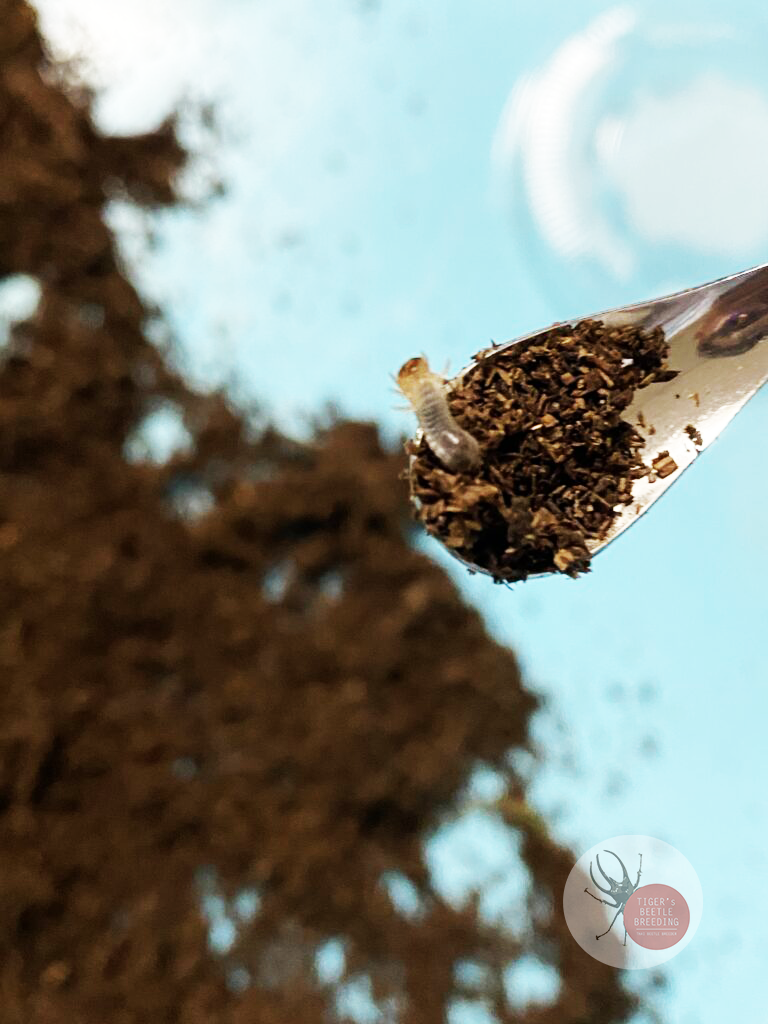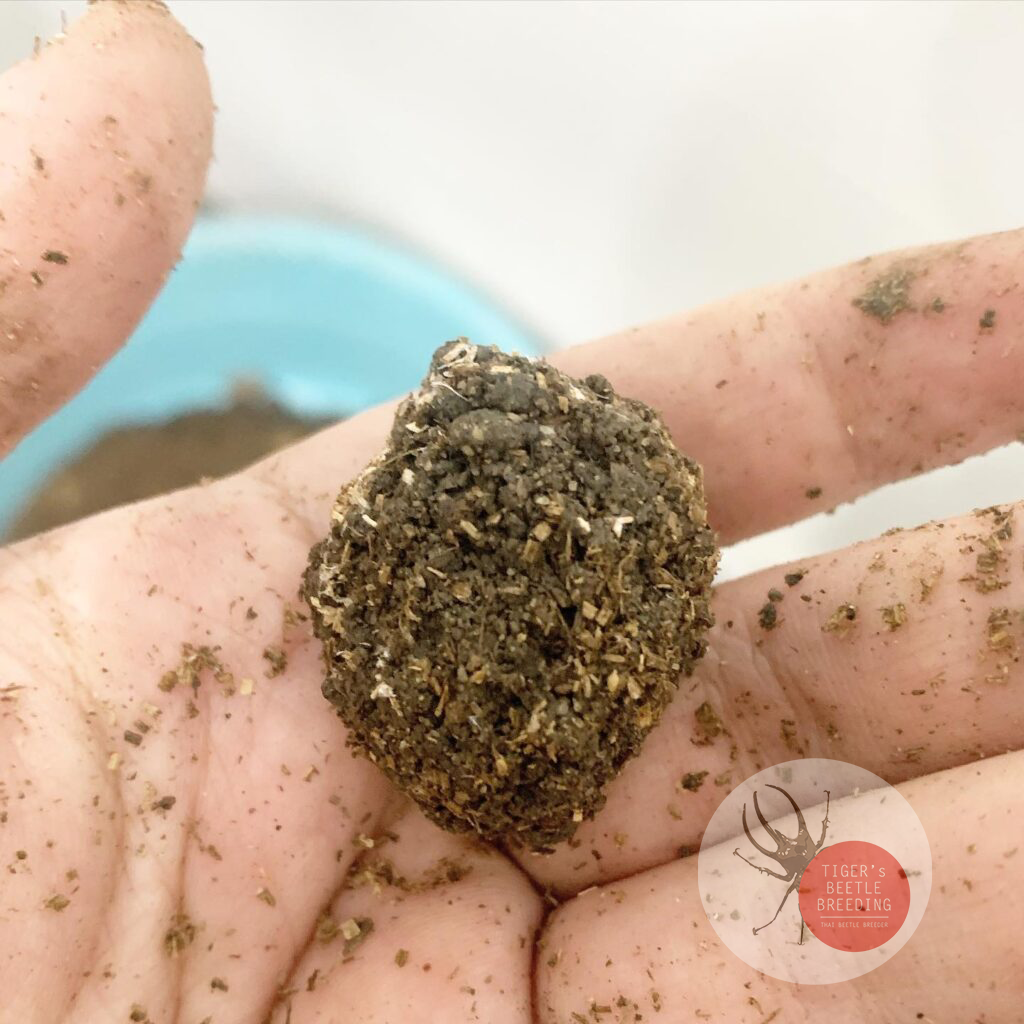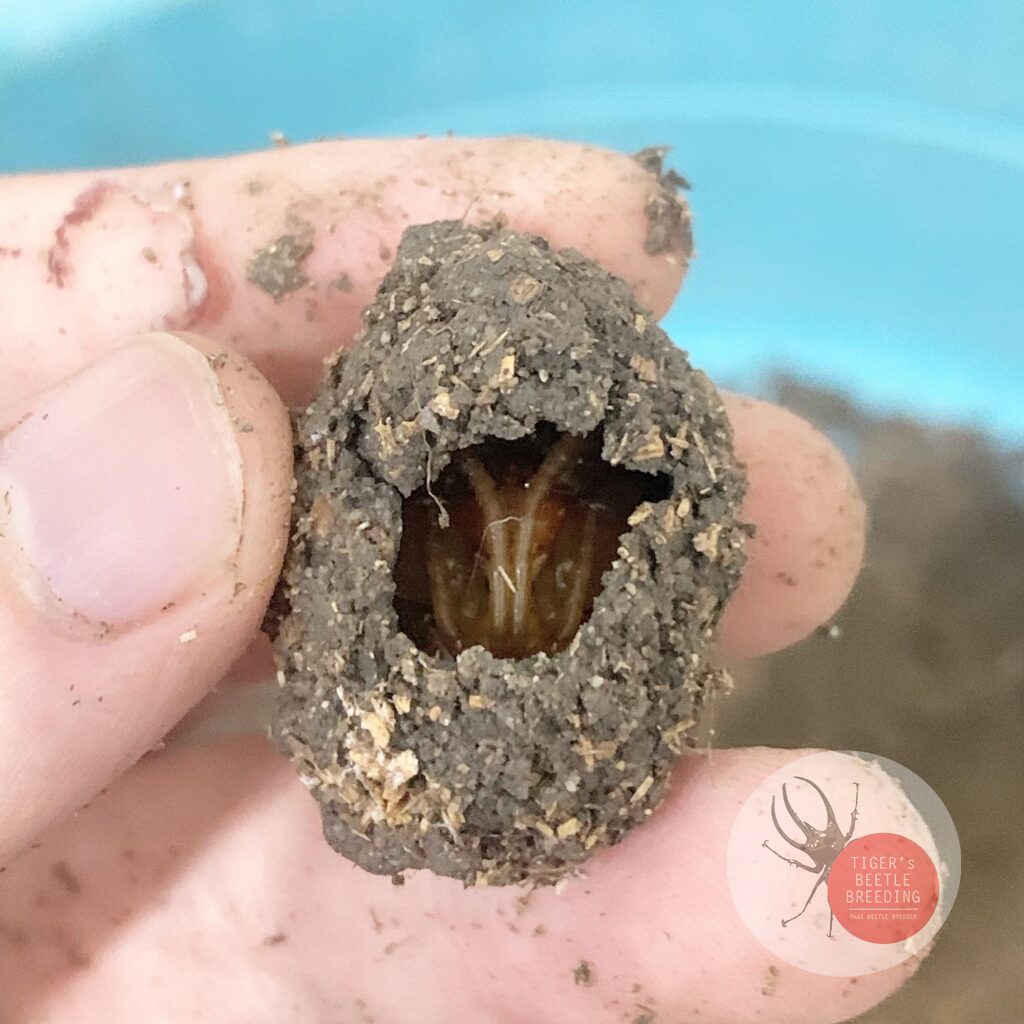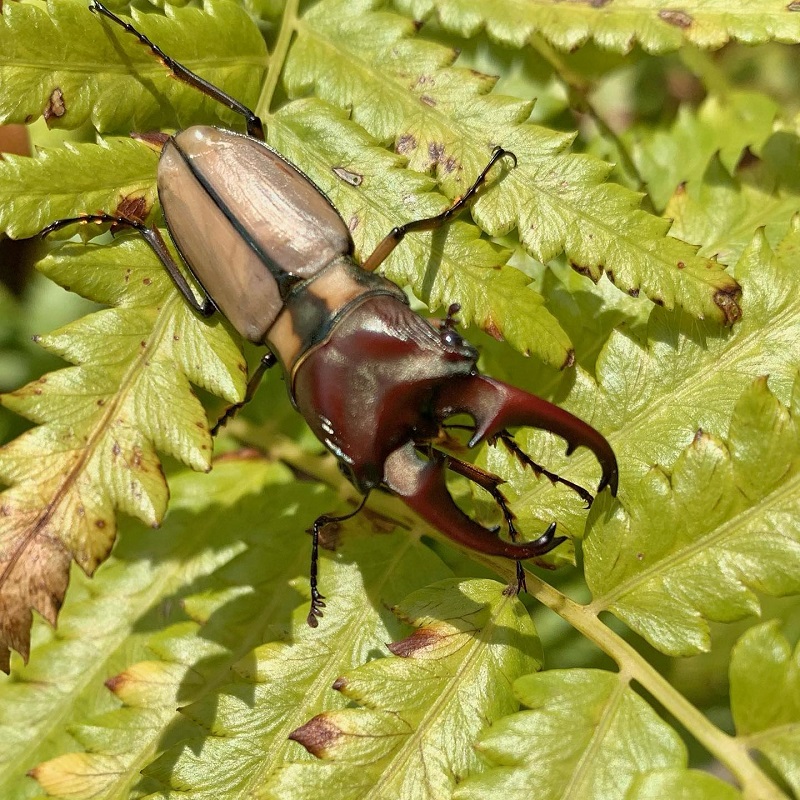Breeding Report of Dicronocephalus wallichii wallichii | รายงานการเพาะด้วงดอกไม้มังกรดอย
Equipment & Materials | อุปกรณ์ และ วัสดุ

ฺBreeding Box from BeetleZ 
Protecting Fruit Fly Filter from BeetleZ 
Flake Soil from BeetleZ 
High Protein Jelly for Beetles 
Barks 
Tiny Wood Sticks from BeetleZ 
Green Moss from แสงล้าน การ์เด้นท์ 
Green Leaves. Picture from acim (BLOGGANG)
| Breeding box (18 ซม. x 29 ซม. x 20 ซม.) | กล่องเพาะ (18 cm. x 29 cm. x 20 cm.) |
| Protecting Fruit Fly Filter | ฟิลเตอร์กันแมลง |
| Flake soil (Any Brands) | แมทกว่าง (ยิ่ห้อใดก็ได้) |
| Barks & Sticks | เปลือกไม้ และ กิ่งไม้ |
| Green Moss or Green Leaves | มอสดินเขียว หรือ ไม้ใบเขียว |
| Beetle Jelly or Fruits | เยลลี่ด้วง หรือ ผลไม้ |
Breeding Box Setup | จัดตู้เพาะด้วง


The method of breeding setting is simulating the environment in a breeding box to be similar to the natural environment with limited conditions. I spent time researching how to breed Dicronocephalus wallichii wallichii in Thai and English forums. But there are a few pieces of information for me to learn how to breed it. So, I had a chance to meet Cyril Lefèvre on Facebook. He had an experience with Dicronocephalus wallichi bourgoini which is a relative species of Dicronocephalus wallichii wallichii. Because two of them are the same genus and species but different subspecies. I assume Dicronocephalus wallichii wallichii can use the same method as Dicronocephalus wallichi bourgoini to breed. So, when I tried to do as Cyril Lefèvre recommended. As the result, it works.
Dicronocephalus wallichii wallichii do not need the height layer of flake soil to lay their eggs. The main point of the breeding setup is the material for making egg cases. As you can see in the pictures above, I used green mosses and fresh green leaves to put on a top layer to let a female use those materials to build the egg cases. I recommend for the fresh leaves should be thin and short. Otherwise, a female is not able to cut the green leaves into small pieces easily. Do not be worried if the green mosses are getting dry. In my experience, a female uses dry materials to build egg cases as well. On my setup, I make short compacted and uncompacted layers.
วิธีการจัดสภาพแวดล้อมในการเพาะด้วงดอกไม้มังกรดอย (Dicronocephalus wallichii wallichii) คือ การจำลองสภาพแวดในตู้เพาะให้ใกล้เคียงกับธรรมชาติในข้อสภาพแวดที่จำกัด ผมใช้เวลาศึกษางานวิจัยของการเพาะด้วงดอกไม้มังกรดอย (Dicronocephalus wallichii wallichii) จากเว็บบอร์ด เว็บไซต์ และฟอรัมทั้งภาษาไทย และภาษาอังกฤษ แต่มันยังมีข้อมูลอยู่เพียงน้อยนิดในการศึกษา ซึ่งผมได้มีโอกาสได้รู้จักกับ Cyril Lefèvre บน Facebook ซึ่งเขามีประสบการณ์ในการเพาะ Dicronocephalus wallichi bourgoini ซึ่งเป็นแมลงที่อยู่ชนิดที่เป็นเครือญาติกันกับ Dicronocephalus wallichii wallichii เพราะทั้งสองชนิดนี้อยู่ในสกุลและชนิดดียวกัน ต่างกันที่ชนิดย่อย ซึ่งผมสมมติฐานว่า ด้วงดอกไม้มังกรดอย (Dicronocephalus wallichii wallichii) สามารถใช้วิธีการเพาะเหมือน Dicronocephalus wallichi bourgoini ได้เช่นกัน ซึ่งเมื่อผมได้ลองทำตามคำแนะนำของ Cyril Lefèvre ผลที่ตามมาคือ มันได้ผล
ด้วงดอกไม้มังกรดอย (Dicronocephalus wallichii wallichii) นั้นไม่ได้ต้องการความสูงของชั้นแมทมากนักในการวางไข่ เมนพอยท์หลัก ๆ ของการจัดตู้เพาะ คือ วัสดุในการสร้างกระเปราะไข่ ดังรูปภาพด้านบนข้างต้น ผมใช้พืขมอสดิน และใบไม้เขียวสดวางลงไปด้านบนของชั้นแมทด้านบนเพื่อให้เพศเมียสามารถใช้วัสดุเหล่านั้นในการสร้างกระเปราะ ผมแนะนำให้ใช้ใบไม้สดที่มีขนาดเล็กและบาง มิฉะนั้นเพศเมียจะไม่สามารถใช้ปากฉีกตัดใบไม้ให้มีขนาดเล็กได้อย่างง่ายดาย ไม่ต้องกังวลถ้าพืชมอสดินเริ่มแห้ง จากประสบการณ์ของผม เพศเมียใช้วัสดุ เช่น เศษใบไม้แห้ง และพืชมอสแห้งเช่นกัน ในการเซ็ทอัพผมใช้ชั้นอัดแน่น และชัดไม่อัดแน่นสูงมาก
The Appearance of Burrow | ลักษณะโพรง

The behavior of Dicronocephalus wallichii wallichii to lay the eggs might be different from other species that I know before. It will use the front legs to make a burrow to be a nest. The depth of the burrow is approximately 4 – 5 cm. I do not know why it does exactly. But from my research, I found that it will drag the materials such as green leaves, green mosses, dry leaves, or etc. to build an egg case. It might take a few hours to build a single egg case.
พฤติกรรมของด้วงดอกไม้มังกรดอย (Dicronocephalus wallichii wallichii) ในการวางไข่อาจแตกต่างจากสายพันธุ์อื่น ๆ ที่ผมรู้จักมาก่อน เพศเมียจะใช้ขาหน้าทำโพรงเป็นรัง ความลึกประมาณ 4 – 5 เซนติเมตร ซึ่งผมเองก็ไม่แน่ใจว่าทำไมถึงทำเช่นนั้น แต่จากที่ผมค้นคว้าและสังเกตุดู ผมพบว่ามันจะลากเอาวัสดุต่าง ๆ เช่น ใบไม้เขียว หรือพืชมอส ใบไม้แห้ง หรืออื่น ๆ ในการสร้างกระเปราะไข่ ซึ่งจะใช้เวลาประมาณ 1 – 2 ชั่วโมงในการสร้าง 1 กระเปราะ

The observations on the nesting behavior of two Dicronocephalus ssp. from the research paper make me assume the behavior of Dicronocephalus wallichii wallichii might be the same exactly. I did not see the process of a female building a burrow with my sights. But I attach the figure from a research paper of Petr Šípek, David Král, and Oldřich Jahn to describe how it is.
จากการสังเกตุในพฤติกรรมสร้างรังของสองชนิดในสกุล Dicronocephalus จากงานวิจัยนี้ืทำให้ผมสมมติฐานว่า พฤติกรรมของด้วงดอกไม้มังกรดอย (Dicronocephalus wallichii wallichii) อาจเป็นแบบเดียวกันอย่างแน่นอน ผมไม่เคยเห็นกระบวนการสร้างโพรงของตัวเมียด้วยตาของผมเอง แต่ผมก็แนบรูปตัวอย่างจากงานวิจัยของ Petr Šípek David Král และ Oldřich Jahn เพื่ออธิบายลักษณะหน้าตาดังภาพด้านบน
The Appearance of Egg Case | ลักษณะของกระเปราะไข่

The egg cases are consist of green mosses and green leaves. It depends on the materials which we put on a breeding box. Please keep in mind that one egg case has only one egg inside.
กระเปราะไขานั่นประกอบไปด้วยพืชมอสและใบไม้เขียว ซึ่งขึ้นอยู่กับวัสดุที่เราใส่ลงไปในถังเพาะ โปรดระลึกไว้เสมอว่า หนึ่งกระเปราะไข่ มีแค่ไข่ฟองเดียว

How to Incubate the Eggs | วิธีการฟักไข่
When I got the egg cases already. I buried the egg cases in the flake soil substrate for a couple of weeks, Then I opened its case to see the larvae. Normally, the eggs take 14 days to hatch. If some egg cases are still eggs, you can put the egg inside the flake soil in a container. I recommend you make a hole in the edge of the container. It is very easy to look at how your larvae progress is.
เมื่อผมได้กระเปราะไข่มาเรียบร้อยแล้ว ผมก็จัดการฝั่งกระเปราะไข่ลงไปในแมทประมาณ 2 – 3 สัปดาห์ หลังจากนั้นผมก็เปิดกระเปราะออกมาดูตัวอ่อน โดยปกติแล้ว ไข่จะใช้เวลา 14 วันในการฟัก หากกระเปราะไข่บางใบ เมื่อเปิดออกมายังคงเป็นไข่ก้อนกลมสีขาวอยู่ ให้ฟักลงไปในแมทในกล่องหรือโหลเตรียมฟักเลย ผมแนะนำให้ทำรูไว้ขอบภาชนะที่ใส่ เพราะมันจะง่ายต่อการสังเกตพัฒนาการของตัวอ่อน
Larval Stages Are Not Easy To Rear | ระยะหนอนไม่ได้เลี้ยงง่ายอย่างที่คิด

As I researched and asked Cyril Lefèvre who had an experience with Dicronocephalus wallichi bourgoini. The main larval food is the flake soil mixed with crushed dry leaves. It makes the larvae develop fast.
อย่างที่ผมค้นคว้าหาข้อมูล และสอบถาม Cyril Lefèvre ผู้ที่มีประสบการณ์ในการเพาะ ด้วงดอกไม้มังกรดอยไต้หวัน (Dicronocephalus wallichi bourgoini) อาหารตัวอ่อนหลัก ๆ คือ แมทกว่างที่ผสมกับใบไม้แห้งบดละเอียด ซึ่งมันส่งผลให้ตัวอ่อนนั่นพัฒนาเจริญเติบโตเร็ว

The information in the statement above is based on “Description of the larvae of Dicronocephalus wallichi bourgoini (Coleoptera: Scarabaeidae: Cetoniinae) with observations on nesting behavior and life cycle of two Dicronocephalus species under laboratory conditions” The reason that I use the information of Dicronocephalus wallichii bourgoini breeding report to be my citation for practicing is my inference of that species might have the same life cycle due to it is the same genus and species. But only different subspecies.
But from my experience, many larvae almost died from L1. On my observation, it might be the humanity that is too wet for my larvae.
And I assume this species usually needs some crushed dry leaves mixed with flake soil to consume. And medium humanity is good.
จากข้อมูลที่ปรากฎในงานวิจัย “Description of the larvae of Dicronocephalus wallichi bourgoini (Coleoptera: Scarabaeidae: Cetoniinae) with observations on nesting behavior and life cycle of two Dicronocephalus species under laboratory conditions” เป็นเหตุผลที่ผมเลือกใช้งานวิจัยชิ้นนี้ในการอ้างอิงสำหรับารปฏิบัติในการเพาะด้วงดอกไม้มังกรดอย เพราะจากการอนุมานของผมว่าสายพันธุ์นี้อาจมีความใกล้เคียงในเชิวงจรชีวิต เนื่องจากอยู่สกุลเดียวกัน สปีชีส์เดียว แค่คนละซับสปีชีส์เท่านั้น
แต่จากประสบการณ์ผม ตัวอ่อนส่วนใหญญ่ตายเกือบหมด ตั้งแต่ระยะแรก (L1) จากการสังเกตุ อาจเป็นเพราะความชื้นมากเกินไปสำหรับตัวอ่อนของผม และผมตั้งข้อสังเกตว่าสายพันธุ์นี้ต้องการใบไม้แห้งที่ผสมในแมทบ้างในการเจริญเติบโตอยู่สม่ำเสมอ และความชื้นปานกลางที่เหมาะสม
Rearing the larvae when they are ready to build cocoons | การเลี้ยงดูตัวอ่อนด้วงดอกไม้เมื่อพวกมันพร้อมที่จะสร้างกระเปราะดักแด้
When the larvae turn L3 already, we can put them on the cocoon substrate. Please make sure that your larvae have the appropriate weight is equal to or higher than 3 grams. If it is less than 3 grams, the larvae will not be able to build a cocoon and die. Cyril Lefèvre told me that before he put the larvae on the cocoon substrate. They have a higher weight around 5 ~ 6 grams.
เมื่อตัวอ่อนของเราเข้าสู่ระยะสุดท้าย (L3) แล้ว เราสามารถใส่พวกมันลงไปบนวัสดุรองพื้นสำหรับทำเกราะเปราะดักแด้ได้เลย โปรดแน่ใจว่าตัวอ่อนของคุณนั้นมีน้ำหนักที่เหมาะสมพอที่จะสร้างกระเปราะ เท่ากับหรือมากกว่า 3 กรัมขึ้นไป หากตัวอ่อนมีน้ำหนักน้อยกว่า 3 กรัม อาจทำให้ตัวอ่อนไม่สามารถาร้างกระเปราะดักแด้ได้ และตายในที่สุด Cyril Lefèvre บอกผมว่าก่อนที่เขาจะใส่พวกมันลงไปในวัสดุรองพื้นสำหรับทำเกราะเปราะดักแด้ พวกตัวอ่อนมีน้ำหนักสูงสุดที่ 5 ~ 6 กรัม
Prepare cocoon substrate | เตรียมรองพื้นสำหรับทำกระเปราะดักแด้
This species is very similar to Goliathus sp. at the third instar of larvae. They will build each cocoon from clay mixed with sand. As I heard from some breeder that used the flake soil to build the cocoon. It didn’t work. As the result, the pupa or larvae will die soon from moisture. The process of preparing the clay mixed with sand to be a cocoon substrate is not very easy and too hard.
Materials for making a cocoon substrate | วัสดุสำหรับทำรองพื้นกระเปราะด้วงดอกไม้
| a kg of Clay. | ดินเหนียวปลูกบัว 1 กิโลกรัม |
| 4 ~ 6 kgs of Elaborated sand. | ทรายละเอียด 4 ~ 6 กิโลกรัม |
| Soil (Optional) | ดิน (ตัวเลือกเสริม) |
Steps to make a cocoon substrate | ขั้นตอนในการทำวัสดุรองพื้นกระเปราะดอกไม้
| 1. Put a kg of clay in a basin. Please make sure that the clay is still wet. If it is not, try to put some water to make it wet. | 1. ใส่ดินเหนียวปลูกบัว 1 กิโลกรัมในกะละมัง โปรดแน่ใจว่าดินเหนียวปลูกบัวยังมีความเหนียวแฉะอยู่ หากไม่มีลักษณะแบบนี้ ลองใส่น้ำลงไปเล็กน้อยให้มีความแฉะ |
| 2. Put 4 ~ 6 kgs of sand in a basin. And mix it well together. | 2. ใส่ทรายละเอียด 4 ~ 6 กิโลกรัม ในกะละมัง แล้วคลุกให้เข้ากัน |
| 3. Check the texture of clay mixed with the sand whether there is sand inside the clay around 65%. If you don’t understand, you can check the video below a table. | 3. เช็คเนื้อของดินเหนียวผสมทราย ว่ามีเนืั้อที่ของทรายผสมไปภายในเนื้อที่ของดินเหนียวอยู่ประมาณ 65% ถ้าไม่เข้าใจให้ดูวีดีโอด้านล่างใต้ตาราง |
| 4. Check the property of the cocoon substrate is easy to compact and still loose. If it is not, you can add soil | 4. เช็คคุณสมบัติของวัสดุรองพื้นที่สำหรับกระเปราะด้วงดอกไม้ คือ ง่ายต่อการอัดแน่น และยังคงมีความหล่วม หากยังไม่ได้มีคุณสมบัติแบบนี้ ให้เพิ่มดินลงไป |
How to set up the area of cocoon substrate for larvae | วิธีการจัดพื้นที่ของวัสดุรองพื้นทำกระเปราะด้วงดอกไม้ให้กับตัวอ่อนด้วงดอกไม้

In this figure, I used the 7.5L of container to rear the remaining three larvae. I put the clay mixed with the sand on the bottom around 45% of 7.5L. And I put the flake soil on the top around 45% of 7.5L as well.
Please keep in mind, we have to use the low temperature for rearing the larvae that will become the pupa at 17 ~ 19 °C.
จากรูปภาพดังกล่าว ผมใช้ถังขนาด 7.5 ลิตร ในการเลี้ยงตัวอ่อนด้วงดอกไม้สามตัว ผมใส่ดินเหนียวปลูกบัวผสมกับทรายด้านล่างประมาณ 45% ของ 7.5 ลิตร และผมก็ใส่แมทด้านบน 45% ของ 7.5 ลิตร เช่นกัน
โปรดระลึกไว้ในใจเสมอว่า เราต้องใช้อุณหภูมิที่ต่ำลงสำหรับการเลี้ยงตัวอ่อนด้วงดอกไม้มังกรดอยที่จะกลายเป็นดักแด้ ในช่วงอุณหภูมิ 17 ~ 19 องศาเซลเซียส
How to Determine Sex & Larval Stages | วิธีการแยกเพศและระยะหนอน
First of All, I would like to thank you for the information from Cyril Lefèvre. He advised me everything that I was concerned about larval stages and the gender of larvae. He said that we could know the larval stages by measuring the cephalic capsule.
ก่อนอื่นทั้งหมด ผมอยากขอบคุณสำหรับข้อมูลจาก Cyril Lefèvre เขาช่วยแนะนำผมทุกอย่างที่ผมกังวลเกี่ยวกับระยะของตัวอ่อนและเพศของตัวอ่อนด้วงดอกไม้มังกรดอย สำหรับการดูระยะตัวอ่อนด้วงดอกไม้มังกรดอย เราจะแยกดูจากหัวของกะโหลกศีรษะ (cephalic capsule) ของตัวอ่อนด้วง
| Cephalic capsule |
| L1 = ~2 mm. |
| L2 = ~3 mm. |
| L3 = ~5 mm. |
For determinating the gender on larval stages. It was determined by a black dot in the bottom of the larvae as in the figure below. If the larvae have a black dot is a male, the larvae don’t have a black dot is a female.
สำหรับการแยกเพศในช่วงระยะตัวอ่อนสามารถแยกได้จากจุดตรงกลางก้น ดังรูปภาพด้านล่าง หากตัวอ่อนด้วงดอกไม้มีจุดสีดำ แสดงว่าเป็นเพศผู้ หากไม่มีจุดสีดำกลางกลางก้น แสดงว่าเป็นเพศเมีย

When I broke a cocoon unguardedly | เมื่อผมเผลอไปทำกระเปราะดักแด้แตก
This accident occurred when I reared them in a pupal container for two or three months. I decided to harvest the cocoon but I was unguarded to avoid breaking the cocoon. It is a very bad result when you found that cocoon was broken. Because it generally is the larva that takes the risk of high death. Then I built the artificial cocoon suddenly. I can’t tell you how to build the correct artificial cocoon from floral foam. But we can imitate the pupal cell wall and the depth from the remaining one.
อุบัติเหตุนี้เกิดขึ้นตอน ผมเลี้ยงพวกมันในถังดักแด้ประมาณ 2 – 3 เดือน ผมตัดสินใจเก็บเกี่ยวตัวกระเปราะดักแด้จากถัง แต่ด้วยความไม่ระมัดระวัง ทำให้กระเปราะดักแด้นั่นแตก ซึ่งเป็นผลลัพธ์ที่แย่มาก ๆ เมื่อเราเจอกระเปราะดักแด้แตก เพราะโดยทั่วไปตัวอ่อนของด้วงดอกไม้ที่อยู่ในกระเปราะดักแด้มีโอกาสเสี่ยงตายสูง

But it’s very lucky when my artificial cocoon works. And my artificial cocoon made the larva turn out to be a pupa completely. So, it took around 5 ~ 7 weeks for shedding its pupal skin to be an adult. I reared it in the refrigerator with a temperature between 17 ~ 20 °C all day.
แต่เป็นเรื่องที่โชคดีมากที่กระเปราะดักแด้เทียมของผมมันเวิร์ค และกระเปราะดักแด้เทียมนี้ก็ทำให้ตัวอ่อนด้วงสามารถกลายร่างเป็นตัวดักแด้ได้อย่างสมบูรณ์ ซึ่งใช้เวลาประมาณ 5 ~ 7 สัปดาห์ในการลอกคราบผิวดักแด้มาสู่ระยะเต็มวัย ผมเลี้ยงไว้ในตู้ควบคุมความเย็นด้วยอุณหภูมิระหว่าง 17 ~ 20 องศาเซียสตลอดทั้งวัน
At that time, I was very excited about my successful breeding of this species. And when I got excited feelings which led to the inappropriate behavior to make my beetle is undeformed finally.
ณ ในเวลานั้น ผมตื่นเต้นกับความสำเร็จในการเพาะด้วงดอกไม้ชนิดนี้มาก และเมื่อความตื่นเต้นนั่นนำไปสู่พฤติกรรมที่ไม่พึงประสงค์ที่ทำให้ด้วงเกิดรูปร่างลักษณะผิดเพี้ยนไป
What happens if your beetle is deformed? | จะเกิดอะไรขึ้นเมื่อด้วงมีรูปร่างไม่สมบูรณ์?
Deformed beetle is often found in the emerged beetle with an artificial chamber or cocoon. The issue is unfolding wings. It takes the cause of death around 50/50 from the deformed beetle. She spent her life very short and suffer from unfolding wings. The assumption of deformed beetle is a disturbance which I did during it is emerging from pupa to adult. This lesson is very precious to me for realizing what should I care for them.
ด้วงที่มีรูปร่างไม่สมบูรณ์ มักพบเจอได้บ่อยจากด้วงในระยะพักตัวด้วยโพรงเทียมและกระเปราะเทียม ปัญหาคือการเก็บปีกไม่สนิท ทำให้เป็นสาเหตุการตายได้ราว ๆ 50/50 จากด้วงที่มีรูปร่างไม่สมบูรณ์ ตัวเมียของผมใช้ชีวิตสั้นมาก ๆ และมีความทุกข์ทรมานจากการที่ปีกเก็บไม่สนิท ซึ่งจากสมมติฐานของด้วงที่มีรูปร่างไม่สมบูรณ์ คือการรบกวน ซึ่งผมทำในระหว่างช่วงระยะพักตัวจากดักแด้สู่เต็มวัย บทเรียนนี้มีความล้ำค่าพอที่ทำให้ผมตระหนักในสิ่งที่ผมควรดูแล
Completed a cocoon | กระเปราะด้วงที่สมบูรณ์


Naturally, the cocoon is built from clay mixed with sand. The clay has the qualification of low humidity than flake soil. There are some breeders who let the larva build the cocoon from flake soil. As the result, the larva will not turn to imago completely from the cause of mold finally making the larva dead. Again, please keep in mind that the pupa should rear at 17 ~ 19 °C.
โดยธรรมชาติแล้ว กระเปราะดักแด้สร้างจากดินเหนียวผสมทราย ซึ่งดินเหนียวนั้นมีคุณสมบัติคือความชื้นต่ำกว่าแมท และมีผู้เพาะพันธุ์บางคนปล่อยให้ตัวอ่อนด้วงดอกไม้มังกรดอยสร้างกระเปราะดักแด้จากแมท ผลที่ตามมาคือตัวอ่อนจะไมาสามารถเข้าสู่ระยะเต็มวัยได้อย่างสมบูรณ์อันเนื่องจากสาเหตุเชื้อราที่ทำให้ตัวอ่อนตายในที่สุด และอีกครั้งโปรดระลึกไว้ว่าตัวดักแด้นั่นควรเลี้ยงไว้ในอุณหภูมิ 17 ~ 19 °C
Conclusion | บทสรุป
Although I can breed this species from the egg to imago the remaining single Dicronocephalus wallichii wallichi was dead a couple of days after emerging. I still don’t know the exact cause of death. I was really upset and sad when I knew I could breed this species completely as I thought. But It’s very thanks to Teacher Num Rittiporn who encouraged me.
If there are some breeders who would like to breed this species. I’m so willing to hint and guide you. And of course, if there are some Dicronocephalus wallichii wallichi in coming April. I will try it again.
ถึงแม้ว่าผมสามารถเพาะด้วงดอกไม้ชนิดจากไข่สู่ระยะเต็มวัยได้ แต่ตัวด้วงดอกไม้มังกรดอย (Dicronocephalus wallichii wallichi) ที่เหลืออยู่นั้นตายอย่างไม่ทรายสาเหตุหลังจากพ้นระยะพักตัวได้ 2 ~ 3 วัน ซึ่งผมเองก็ไม่ทราบสาเหตุที่แน่ชัดว่าตายด้วยสาเหตุอะไร ผมหัวเสียและเสียใจอย่างมาก เมื่อรู้ว่าผมไม่สามารถเพาะด้วงดอกไม้สายพันธุ์ชนิดได้อย่างสมบูรณ์อย่างที่ใจคิด แต่ผมก็ขอบคุณครูหนุ่ม ฤทธิพร มาก ๆ ที่ให้กำลังใจแก่ผม
หากมีคนไหนอยากเพาะสายพันธุ์นี้ ผมยินดีที่ให้ความช่วยเหลือและแนะนำ และแน่นอนว่า ถ้าหากมีด้วงดอกไม้มังกรดอยโผล่มาอีกในเดือนเมษ่ยนที่จะถึงนี้ ผมจะลงเพาะอีกครั้ง

Dicronocephalus wallichii wallichii ด้วงดอกไม้มังกรดอย ワーウィック ハナムグリBreeding Date: 17th May 2021 Mating Date: 5th May 2021 Generation: WF1
Citation | แหล่งอ้างอิง
- Šípek, P., Král, D. and Jahn, O., 2008. Description of the larvae of Dicronocephalus wallichi bourgoini (Coleoptera: Scarabaeidae: Cetoniinae) with observations on nesting behavior and life cycle of two Dicronocephalus species under laboratory conditions. [online] ResearchGate. Available at: <https://www.researchgate.net/publication/234127597_Description_of_the_larvae_of_Dicronocephalus_wallichi_bourgoini_Coleoptera_Scarabaeidae_Cetoniinae_with_observations_on_nesting_behavior_and_life_cycle_of_two_Dicronocephalus_species_under_laboratory_> [Accessed 7 June 2021].















